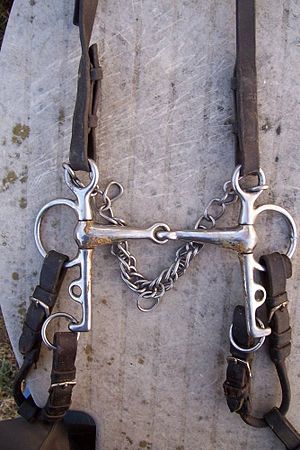Tack is equipment or accessories equipped on horses and other equines in the course of their use as domesticated animals. This equipment includes such items as saddles, stirrups, bridles, halters, reins, bits, and harnesses. Equipping a horse is often referred to as tacking up. A room to store such equipment, usually near or in a stable, is a tack room.

A bridle is a piece of equipment used to direct a horse. As defined in the Oxford English Dictionary, the "bridle" includes both the headstall that holds a bit that goes in the mouth of a horse, and the reins that are attached to the bit.
A halter or headcollar is headgear that is used to lead or tie up livestock and, occasionally, other animals; it fits behind the ears, and around the muzzle. To handle the animal, usually a lead rope is attached. On smaller animals, such as dogs, a leash is attached to the halter.

Longeing or lungeing is a technique for training and exercising horses. It is also a critical component of the sport of equestrian vaulting.

A noseband is the part of a horse's bridle that encircles the nose and jaw of the horse. In English riding, where the noseband is separately attached to its own headstall or crownpiece, held independently of the bit, it is often called a cavesson or caveson noseband. In other styles of riding, a simple noseband is sometimes attached directly to the same headstall as the bit.

A pelham bit is a type of bit used when riding a horse. It has elements of both a curb bit and a snaffle bit. In this respect a pelham bit functions similar to a double bridle, and like a double bridle it normally has "double" reins: a set of curb reins and a set of snaffle reins. Because it has a bit shank and can exert curb-style pressure on the horse, it is considered a curb bit. Like all curb bits, a pelham bit has a mouthpiece, shanks with both purchase and lever arms, a ring for rein attachment at the bottom of the shank, and a curb chain. But like a snaffle bit, a pelham bit also has a bit ring on either side of the mouthpiece. Like some curb bits, a pelham bit usually has "loose" shanks - hinged at the mouthpiece in the same way that the rings of a snaffle bit are hinged. When two sets of reins are used, the snaffle rein generally is wider, to help distinguish it from the curb. A "cowboy pelham" is a western style of loose-jawed curb bit with additional rings at the mouthpiece allowing a second set of reins to be added.

A snaffle bit is the most common type of bit used while riding horses. It consists of a bit mouthpiece with a ring on either side and acts with direct pressure. A bridle utilizing only a snaffle bit is often called a "snaffle bridle", particularly in the English riding disciplines. A bridle that carries two bits, a curb bit and a snaffle, or "bradoon", is called a double bridle.

A Kimblewick, Kimberwicke or Kimberwick is a type of bit used on a horse, and named after the English town of Kimblewick where it was first made. The bit has bit shanks, D-shaped rings, and a curb chain. Due to its shanks, it is regarded as a type of curb bit. The curb action is minimal to mild, however, because the shanks have short purchase arms and no lever arms. Some variations increase the curb action. A Kimblewick is used with one set of reins.
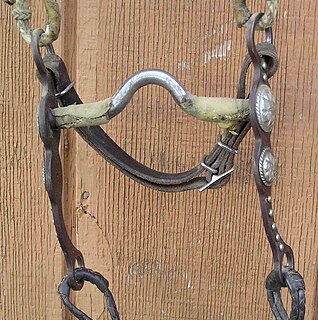
A curb bit is a type of bit used for riding horses that uses lever action. It includes the pelham bit and the Weymouth curb along with the traditional "curb bit" used mainly by Western riders.
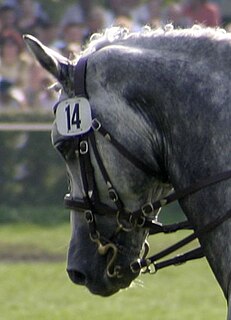
A double bridle, also called a full bridle or Weymouth bridle, is a bridle that has two bits and four reins. One bit is the bradoon, is a modified snaffle bit that is smaller in diameter and has smaller bit rings than a traditional snaffle, and it is adjusted so that it sits above and behind the other bit, a curb bit. Another term for this combination of curb and snaffle bit is a "bit and bradoon", where the word "bit" in this particular context refers to the curb.
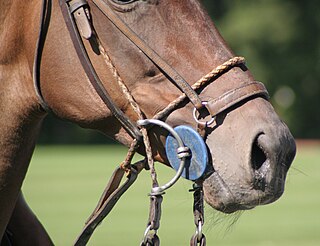
The gag bit is a type of bit for a horse. Because the cheek piece and reins attach to different rings there is leverage action. Severity of leverage action depends on where the reins attach. For example, in a Dutch Gag, the further the rein attachment from the mouthpiece the greater the leverage. The gag bit is related to a Pelham bit and a double bridle but the gag bit has no curb strap.
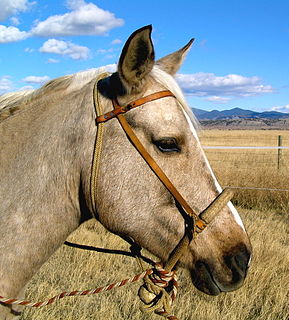
A hackamore is a type of animal headgear which does not have a bit. Instead, it has a special type of noseband that works on pressure points on the face, nose, and chin. Hackamores are most often seen in western riding and other styles of riding derived from Spanish traditions, and are occasionally seen in some English riding disciplines such as show jumping and the stadium phase of eventing. Various hackamore designs are also popular for endurance riding. While usually used to start young horses, they are often seen on mature horses with dental issues that make bit use painful, and on horses with mouth or tongue injuries that would be aggravated by a bit. Some riders also like to use them in the winter to avoid putting a frozen metal bit into a horse's mouth.
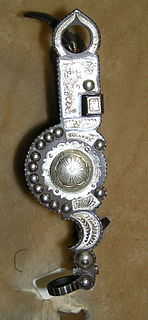
The bit shank is the side piece or cheekpiece of a curb bit, part of the bridle, used when riding on horses. The bit shank allows leverage to be added to the pressure of the rider's hands on the bit. Shanks are usually made of metal, may be straight or curved, and may be decorated in some disciplines. The headstall and curb chain or curb strap of the bridle is attached to the top of the shank, and the reins are attached at the bottom. Shanked curb bits are used in western riding for nearly all adult horses, and are seen in English riding disciplines primarily as part of the double bridle used by advanced dressage riders, and on the hybrid pelham bit that includes a ring for a second rein attached at the bit mouthpiece.

A mechanical hackamore is a piece of horse tack that is a type of bitless headgear for horses where the reins connect to shanks placed between a noseband and a curb chain. Other names include "hackamore bit", "brockamore", "English hackamore", "nose bridle" and "German hackamore". Certain designs have been called "Blair's Pattern" and the "W. S. Bitless Pelham".
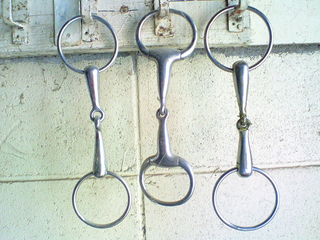
The bit ring is the ring on the side of a horse's bit, particularly on a snaffle bit. It is used as a point of attachment for the cheekpieces of the bridle and for the reins. It also has an effect on the action of the bit. Therefore, the design of the ring is something to consider when choosing a bit for a horse, even though the bit mouthpiece generally has a greater effect than the ring.

The mouthpiece is the part of a horse's bit that goes into the mouth of a horse, resting on the bars of the mouth in the sensitive interdental space where there are no teeth. The mouthpiece is possibly the most important determinant in the severity and action of the bit. Some mouthpieces are not allowed in dressage competition.

The bit is an item of a horse's tack. It usually refers to the assembly of components that contacts and controls the horses mouth, and includes the shanks, rings, cheekpads and mullen, all described here below, but it also sometimes simply refers to the mullen, the piece that fits inside the horse's mouth. The mullen extends across the horse's mouth and rests on the bars, the region between the incisors and molars where there are no teeth. The bit is located on the horse's head by the headstall, and which has itself several components to allow the most comfortable adjustment of bit location and control.
Horse harness is a device that connects a horse to a vehicle or another type of load.

A bitless bridle is a general term describing a wide range of headgear for horses or other animals that controls the animal without using a bit. Direction control may also be via a noseband or cavesson, if one is used. The term hackamore is the most historically accurate word for most common forms of bitless headgear. However, some modern bitless designs of horse headgear lack the heavy noseband of a true hackamore and instead use straps that tighten around a horse's head to apply pressure in various ways. These are often specifically patented and marketed as "bitless bridles", usually referencing a particular type of headgear known as the cross-under, though other designs are sometimes also given similar names.
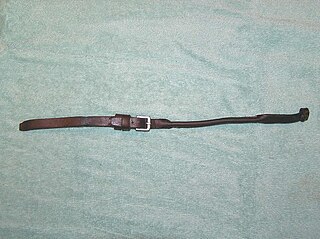
A lip strap is a piece of horse tack made of rolled leather or occasionally thin chain, used sometimes on some types of English-style curb and pelham bits. The lip strap runs between the bit shanks and passes through a special center ring on a curb chain sometimes called the "fly link". The lip strap attaches to rings at midpoint of the shanks and buckles on the near side.
Price, Steven D., ed.The Whole Horse Catalogue. New York: Simon and Schuster/Brigadore Press, 1977



